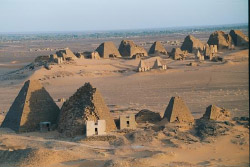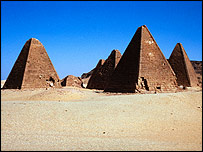
|
HiddenMysteries.com HiddenMysteries.net HiddenMysteries.org |
* * * * * * * * * * * * * * * * * * * * * * * * * * * * * * * * * * * * * * *
A word from our sponsor

Sudan: The Land of Pyramids
Thursday, February 01 2007 @ 10:21 PM CST
Increase font Decrease font
This option not available all articles
By: Isaac Amke
There are probably more pyramids in Sudan than can be found in all of Egypt. Yet the wonders of ancient Egypt are known worldwide, while those of its southern neighbor stand forgotten on the banks of the Nile.
The checkered political history of Sudan, combined with the country's rugged terrain and lack of modern conveniences, has kept tourists away from some of the most romantic archeological sites in the world, among them several whole fields of pyramids.
The oldest Sudanese pyramids, dating back to the eighth century BC, stand near the modern city of Karima, downriver from the Fourth Cataract of the Nile. They were built for the kings of Kush, as the land was known in antiquity, who - after conquering Egypt around 730 BC - adopted the old pharaonic tradition of erecting monumental tombs for themselves and members of their families. These pyramids were smaller than the Egyptian ones, and were located near the Kushite capital city of Napata, which once existed in the neighborhood of Karima.
These Napatan conquerors of Egypt, despite their adherence to Egyptian customs and religious beliefs, preferred to be buried not in the land they won but near their home town; after their eventual expulsion from Egypt by the Assyrians, around 660 BC, they really had no other choice, and the»burials continued.
It was also near Napata that one of the most important temples in the entire Nile Valley, the Great Temple of Amun, had been erected by the Egyptian pharaohs in the 15th century BC, at the foot of an impressive mountain called Jabal Barkal. Its massive ruins can still be seen in the desert sands.
We owe our knowledge of the Sudanese pyramids to an American archeologist, George A. Reisner, who on behalf of the Boston Museum of Fine Arts and Harvard University spent several winters between 1916 and 1923 excavating the Napatan pyramids as well as those at Meroe, a site only 210 kilometers (130 miles) north of Khartoum. While his work represented the first truly scholarly examination of these monuments, he was not the first to explore them. A hundred years before Reisner, various European travelers had passed by and left descriptions, often very detailed ones, of the Napatan and Meroitic pyramids (See box, page 9).
One of those travelers, an Italian doctor turned treasure-hunter by the name of Giuseppe Ferlini, went a step further and in 1834 began "exploring" the monuments. His goal was simple: to find the great treasures that rumor claimed were hidden inside the pyramids. According to his published account, he employed a very "efficient" - today we would say "barbarous" - method of conducting his treasure hunt: a laborious and systematic dismantling of the structures, one after another, from the top down. The tragedy, from the point of view of the modern archeologist, is that he did indeed find beautiful gold jewelry in one of the Meroe pyramids! These royal treasures eventually found their way to the museums in Munich and Berlin, and since that time have often been displayed in international exhibitions, such as the one that toured various American and European museums in 1978 (See Aramco World, July-August 1979). Fortunately, despite the explorations of Ferlini and his followers, many of the pyramids survived intact.
Sudan has more pyramids that Egypt
A common feature of all the pyramid fields was their location on high ground, as if to make up for their deficiency in size when compared to the Egyptian counterparts. They were built of sandstone blocks and gave no appearance of having interior burial chambers. These, as it turned out, were cut into the bedrock beneath the pyramid and were reached by a long stairway that began some distance in front of the pyramid and outside the wall that surrounded it. Above the stairway, abutting the pyramid itself, was erected an offering chapel, profusely decorated with reliefs depicting various religious scenes. The reliefs in the chapels and the painted decoration of the burial chambers were largely Egyptian in style, although some elements were more African in character.
While many of the pyramids were robbed in ancient and, as in Ferlini's case, in more recent times, there was still plenty to be discovered, as Reisner quickly learned. Thousands of small funerary statuettes called shawabtis, small gold objects, wooden coffins, inscribed stelae, hundreds of pots and many other objects came to light during Reisner's excavations and are now proudly displayed in the museums in Boston and Khartoum. They all bear witness to the high degree of artistic and economic development of this lost kingdom on the Nile.
Many of the earliest objects were inscribed with Egyptian hieroglyphs and thus provided clues to the identity of the owners, enabling Reisner and his assistant, Dows Dunham, to establish an outline of the royal chronology. Such clues, however, were not always available, and Reisner was faced with the double problem of identifying the "owners" of the remaining unassigned pyramids, and finding out where they probably fell in the regnal sequence. This task was further complicated by the introduction, in the third century BC, of a native writing system which, Jo this day, has not been deciphered (See Aramco World, July-August 1983).
Reisner's solution was remarkable in its simplicity; he simply assumed that the most attractive and visible position in any given cemetery had been occupied first, and that the succeeding burials had been arranged farther and farther away. By combining this locational approach with a stylistic and architectural analysis of the pyramids, Reisner was able to establish a chronology which, with modifications, is still used by historians today.
The modern visitor is less apt to travel to far-away Karima, but a day trip from Khartoum to Meroe is quite easy. Reisner himself worked on the three pyramid fields of Meroe (300 BC to AD 350), and other scholars excavated the ruins of Meroe city, which the well-known British writer Basil Davidson described as one of the largest archeological sites in the world. Since the Meroe pyramids are now a prime tourist attraction, the Sudanese authorities have launched a conservation and reconstruction program to make good the deeds of Ferlini and his ilk and to develop the site for tourists - including the restoration of some of the pyramids to their original state. However, tourists are not yet flocking to Meroe in great numbers. This makes the place uniquely attractive compared with other, usually overcrowded ancient sites, and gives the visitor a chance to admire some of the most magnificent monuments of the African continent in peaceful solitude. Spending a night in the desert under the beautiful southern sky, near pyramids built centuries ago for the powerful kings of Kush, is an experience without compare.
[by Krzysztof Grzymski]
Krzysztof Grzymski, an archeologist, is associate curator of the Egyptian Department of the Royal Ontario Museum in Toronto.



http://www.kenyanewsnetwork.com
Comments (0)
* * * * * * * * * * * * * * * * * * * * * * * * * * * * * * * * * * * * * * *
A word from our sponsor

HiddenMysteries
Main Headlines Page
Main Article Page
Sudan: The Land of Pyramids
http://www.hiddenmysteries.net/newz/article.php/2007020122214280
Check out these other Fine TGS sites
HiddenMysteries.com
HiddenMysteries.net
HiddenMysteries.org
RadioFreeTexas.org
TexasNationalPress.com
TGSPublishing.com
ReptilianAgenda.com
NationofTexas.com
Texas Nationalist Movement